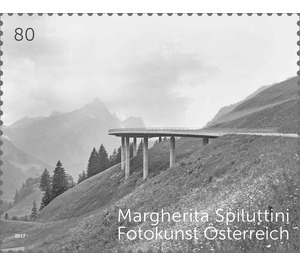Modern Art - Austria / II. Republic of Austria 2017 - 80 Euro Cent
Theme: Art & Culture
| Country | Austria / II. Republic of Austria |
| Issue Date | 2017 |
| Face Value | 80.00 |
| Edition Issued | 175,000 |
| Perforation | 14 x 13½ |
| Printing Type | offset |
| Stamp Type | Commemorative |
| Item Type | Stamp |
| Chronological Issue Number | 2661 |
| Chronological Chapter | OOS-OE2 |
| SID | 665769 |
| Dimensions | 41.00 x 50.00 |
| In 77 Wishlists | |
The Salzburg artist Margherita Spiluttini is one of the most renowned photographers in Austria. The stamp shows a black and white photograph of the Hochtannberg in the summer of 1992, barite print on aluminum laminated. The photograph comes from the project "After the Nature - Constructions of the Landscape" from the years 1991 to 2003. It is "about the ambivalence between the poignant beauty of the mountains and the oppressive threat that can emanate from it. Of what happens when people want to overcome, dominate and use the gigantic and impassable mountain, and how the "surface" mountain changes. " Margherita Spiluttini was born in Schwarzach in Salzburg in 1947 and worked as a freelance photographer from 1981 to 2014 when her multiple sclerosis finally put her in a wheelchair. From 1998 to 1999, she was a lecturer at the University of Applied Arts in Vienna, followed by a visiting professorship at the University of Art and Design in Linz. For several years she was a member of the board of the Vienna Secession. In 2006, the artist living and working in Vienna was honored with the Austrian Cross of Honor for Science and Art, and in 2016 with the Austrian State Prize for Artistic Photography. For photography, she came across her job as a medical-technical assistant at the AKH: "My first photos were radioactive and radiological interior photographs of the body," says the artist in an interview for the newspaper "The Standard". On landscape photos, which are strongly influenced by the profession of her father as a master builder, followed the architectural photography. Her photo archive, in which more than 4,000 buildings and objects are documented, can be found in the Architekturzentrum Wien.


